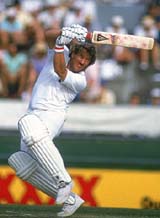The regular Monday column in which our editor answers your questions about (almost) any aspect of cricket:
Who was the first person to score a century and take a five-for in the same Test, and who has done it most often? asked Robert Soames from Canterbury
The first person to do score a century and take five wickets in an innings in the same Test was the South African
Jimmy Sinclair, who followed his 6 for 26 against England
at Cape Town in 1898-99 with an innings of 116. That was also South Africa's first century in a Test match. It didn't happen again for more than ten years (the next person to do it was another South African,
Aubrey Faulkner), and is still quite rare - as
this list shows, it has only been done 26 times in Test matches in all. Five of those were achieved by England's
Ian Botham.
Why doesn't Shahid Afridi appear on the list of players with a century in their first ODI? asked Mujahid Ahmed from Lahore
Shahid Afridi's not there because he didn't actually bat in his debut ODI, against Kenya
in Nairobi in 1996-97 - he was down at No. 9 and didn't get in. But in his next match he was promoted to No. 3, on the evidence of some big hitting in the nets, and blitzed a century in 37 balls - still the fastest in all ODIs - against Sri Lanka
at the Nairobi Gymkhana. The fact that he had already played a match means he's a footnote on the list of players
scoring hundreds on ODI debut. There are only four people who made a hundred in their very first one-dayer: Desmond Haynes leads the way with 148 on his debut, for West Indies against Australia
at St John's in 1977-78, but Afridi is the only man to score a hundred in his first innings, not having batted in his first match.
In 1957-58 Conrad Hunte made 246 when Garry Sobers scored his 365 not out. Is this the highest score not be the highest in a Test innings? asked Robin Brodhurst
Actually
Conrad Hunte made 260 in that match against Pakistan
at Kingston - but it is indeed the highest score not to be the highest in a Test innings. In second place is Marvan Atapattu, with 249 for Sri Lanka against Zimbabwe
at Bulawayo in 2003-04 - he was trumped by Kumar Sangakkara's 270 (they shared a stand of 438: Hunte and Sobers had put on 446) . But Hunte's knock isn't quite the biggest one not to be the highest score in an entire Test:
at Wellington in 1990-91 Aravinda de Silva hit 267 for Sri Lanka, but was overhauled by Martin Crowe, who cracked 299 for New Zealand.
Jim Laker played for Essex in the 1960s, apparently as an amateur, after he retired from regular cricket with Surrey. How did he do? asked Tom Skelton
In all
Jim Laker, arguably England's greatest-ever offspinner, played 30 matches for Essex between 1962 and 1964, apparently as a result of a casual conversation with Essex's captain, Trevor Bailey. He took 111 wickets at an average of 21.32, with a best of 7 for 73 against Kent
at Dover in 1962. He took 6 for 86 in the second innings, to finish with 13 wickets in the match. One thing I'd forgotten about Laker (if I ever knew it) was that in 1951-52 he played four matches in New Zealand's domestic competition, for Auckland, while he was out there coaching at the local university. He did pretty well there too, taking 24 wickets at 15.79.
I noticed that all of Wisden's Five Cricketers of the Year for 2005 were Englishmen - when was the last time this happened? asked Ronald Lowe from Bolton
The last time this happened was in 1960, when the Five were Ken Barrington, Donald Carr, Ray Illingworth, Geoff Pullar and Mike Smith.
Click here for a full list of
Wisden's Cricketers of the Year. This year's famous five were Ashley Giles, Steve Harmison, Robert Key, Andrew Strauss and Marcus Trescothick (remember that the players are chosen on the basis of their efforts in the previous English season, and no-one can receive the accolade more than once). For more about this year's Almanack, including the Cricketer of the Year essays,
click here.
I see that Don Bradman made one stumping in his first-class career. How did this come about? asked Anand Kumar Rao from India
The stumping came in a Sheffield Shield match between Bradman's adopted state, South Australia, and his old one, New South Wales,
at Sydney in 1937-38. South Australia's regular wicketkeeper,
Charlie Walker (who toured England the following summer) injured a finger, and Bradman took over. BJ Wakley's statistical tome
Bradman the Great, which analyses every conceivable aspect of The Don's career, records: "He showed his versatility by keeping wicket ... his record being five byes and a stumping in the first innings, and three byes and three good catches in the second."
Wisden described his keeping as "first-rate". The stumping would doubtless have given Bradman great satisfaction: the batsman was
Bill O'Reilly, with whom he had a somewhat fractious relationship over the years. O'Reilly was stumped by Bradman off the legspinner Frank Ward for 20. In between his keeping duties Bradman scored 104 not out - but his side still lost by four wickets.
